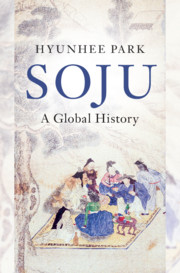Book contents
- Soju
- ASIAN CONNECTIONS
- Soju
- Copyright page
- Dedication
- Contents
- Maps
- Illustrations
- Acknowledgments
- Note on Transliteration and Other Conventions
- Introduction
- 1 Soju and Arak
- 2 The Mongols and the Rise of Soju in Koryŏ Korea
- 3 Contextualizing Soju
- 4 Distilling Soju at Court and Home in Chosŏn Korea
- 5 Challenges of Modernity
- 6 Alcohol Globalism
- Conclusion
- Works Cited
- Index
- Asian Connections
5 - Challenges of Modernity
The Rise of Modern Industrial Soju and the Revival of Traditional Soju
Published online by Cambridge University Press: 21 January 2021
- Soju
- ASIAN CONNECTIONS
- Soju
- Copyright page
- Dedication
- Contents
- Maps
- Illustrations
- Acknowledgments
- Note on Transliteration and Other Conventions
- Introduction
- 1 Soju and Arak
- 2 The Mongols and the Rise of Soju in Koryŏ Korea
- 3 Contextualizing Soju
- 4 Distilling Soju at Court and Home in Chosŏn Korea
- 5 Challenges of Modernity
- 6 Alcohol Globalism
- Conclusion
- Works Cited
- Index
- Asian Connections
Summary
Chapter 5 explores the great transformations that soju has undergone during the contemporary period, which spans the twentieth and twenty-first centuries, and the consequences of that change for the societies that have consumed the spirit. During the period of Japanese colonial rule (1910–1945), new distillation methods introduced to Korea from Japan fundamentally changed the methods of distillation from the traditional still to continuous distillation using large machines. Even after the end of Japanese colonialism, and the Korean War (1950–1953), the Korean government supported factory-manufactured soju made from potatoes because the country lacked grain. Only in the 1980s did the government begin to promote traditionally distilled soju as a minsokchu (national folk liquor), part of its policy of promoting national culture. At the same time, the modern form of industrial soju continued to develop in variety, contributing to the popularization of soju at cheaper prices, at different levels of alcohol content, and with a variety of tastes. With these developments underway, producers began to export soju to other countries, in the long run making it into a global brand. With these dramatic changes in its production, distribution, and consumption, people began to debate what constituted traditional soju.
Keywords
- Type
- Chapter
- Information
- SojuA Global History, pp. 164 - 199Publisher: Cambridge University PressPrint publication year: 2021

